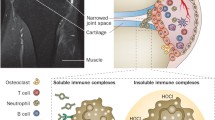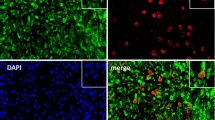Abstract
Neutrophils constitute over 90% of cells found in the synovial fluid of rheumatoid arthritis (RA) patients. Since such fluids also contain immune complexes (IgG-IgG and IgG-IgM rheumatoid factors) and complement split products (C5, C5A, DES, ARG, C3B, etc.), all of the reactants are present for a local Arthus lesion. Moreover, neutrophils from RA patients endocytose these immune complexes and complement components in vivo and in vitro. In consequence, it has been suggested that lysosomal enzymes and other mediators of inflammation released by neutrophils after uptake of immune complexes (in the bulk phase or on the surface) account, at least in part, for rheumatoid inflammation. Secretion of lysosomal hydrolases, especially neutral proteases, which provoke tissue injury and generation of reactive oxygen species (e.g. O2) is part of a stimulus-secretion response to a variety of secretagogues, including immune complexes and complement components. However, the pathways of secretion and O2 generation are stimulus-specific and can be dissected to establish cause and effect relationships by (a) kinetic analysis, (b) varying the stimulus, (c) use of impermeant reagents to block discrete responses. Neutrophils also generate products of 11-cyclo-oxygenase (e.g., PGE2, TXA2) and of the 5- and 15-lipoxygenase (mono-, di-and trihetes, LTB4 and their isomers). However, the cyclo-oxygenase products (except TXA2) do not cause inflammation acting alone; indeed, they inhibit the function of neutrophils, platelets, macrophages and mast cells. The most potent proinflammatory agent yet identified as a product of arachidonate is LTB4. LTB4 is a potent Ca ionophore, a strong chemo-attractant, induces local inflammation, and activates neutrophils.
Similar content being viewed by others
References
Smolen, J. E., H. M. Korchak, andG. Weissmann. 1980. Increased levels of cyclic adenosine-3′, 5′-monophosphate in human polymorphonuclear leukocytes after surface stimulation.J. Clin. Invest. 65:1077–1085.
Cohen, H. J. andM. E. Chovaniec. 1978. Superoxide anion generation by digitonin-stimulated guinea-pig granulocytes. A basis for a continuous assay for monitoring Superoxide production and for the study of the activation of the generating systems.J. Clin. Invest. 61:1081–1087.
Smolen, J. E., H. M.Korchak, and G.Weissmann. 1983. Kinetics of degranulation of human neutrophils as measured by self-quenching of 9-aminoacridine.Biochim. Biophys. Acta (in press).
Sklae, L. A., V. M. McNeil, A. J. Jesaitis, R. G. Painter, andC. G. Cochrane. 1982. A continuous, spectroscopic analysis of the kinetics of elastase secretion by neutrophils.J. Biol. Chem. 257:5471–5475.
Kaplan, H. B., H. S. Edelson, R. Freidman, andG. Weissmann. 1982. The roles of degranulation and Superoxide anion generation in neutrophil aggregation.Biochem. Biophys. Acta 721:55–63.
Sklar, L. A., Z. G. Oades, A. J. Jesaitis, R. G. Painter, andC. G. Cochrane. 1981. Fluoresceinated chemotactic peptide and high-affinity antifluorescein antibody as a probe of the temporal characteristics of neutrophil stimulation.Proc. Natl. Acad. Sci. U.S.A. 78:7540–7544.
Radin, A. R., H. M. Korchak, C. Wilkenfeld, L. E. Rutherford, andG. Weissmann. 1982. Differential requirements for receptor occupancy in neutrophil responses to a chemoattractant.Clin. Res. 30:520A.
Korchak, H. M., A. M. Rich, C. Wilkenfeld, L. E. Rutherford, andG. Weissmann, 1982. A carbocyanine dye, DiOC6(3), acts as a mitochondrial probe in human neutrophils.Biochem. Biophys. Res. Comm. 108:1495–1501.
Seligmann, B. E., E. K. Gallin, D. L. Martin, W. Shain, andJ. I. Gallin. 1980. Interaction of chemotactic factors with human polymorphonuclear leukocytes: Studies using a membrane potential sensitive cyanide dye.J. Memb. Biol. 52:257–272.
Weissmann, G., S. Hoffstein, H. Kochak, andJ. E. Smolen. 1979. The earliest membrane responses to phagocytosis: Membrane potential changes and Canloss in human granulocytes.Trans. Am. Assoc. Physicians 91:90–101.
Williams, J. A. 1980. Regulation of pancreatic acinar cell function by intracellular calcium.Am. J. Physiol. 238:G269-G279.
Douglas, W. W. 1974. Involvement of calcium in exocytosis and the exocytosisvesiculation sequence.Biochem. Soc. Symp. 39:1–28.
Putney, J. E. 1979. Stimulus-permeability coupling; role of calcium in the receptor regulation of membrane permeability.Pharmacol. Rev. 30:209–245.
Goldstein, I. M., J. K. Horn, H. B. Kaplan, andG. Weissmann. 1974. Calcium induced lysozyme secretion from human polymorphonuciear leukocytes.Biochem. Biophys. Res. Comm. 60:807–812.
O'Flaherty, J. T., H. J. Showell, E. L. Beckee, andP. A. Ward, 1978. Substances which activate neutrophils. Mechanism of action.Am. J. Path. 92:155–166.
Smith, R. J., andS. S. Iden. 1980. Properties of concanavalin A-elicited granule exocytosis from human polymorphonuclear neutrophils.Inflammation.4:343–358.
Smith, R. J., W. Wierenga, andS. Iden. 1980. Characteristics of N-fromyl-methionylleucyaphenylalanine as an inducer of lysosomal enzyme release from human neutrophils.Inflammation.4:73–88.
Smolex, J. E., H. M. Korchak, andG. Weissmann. 1981. The roles of extracellular and intraceliular calcium in lysosomal enzyme release and Superoxide anion generation by human neutrophils.Biochim. Biophys. Acta 677:512–520.
Malagodi, M. H., andC. Y. Chiou. 1974. Pharmacological evaluation of a new calcium antagonist 8-(N,N-diethyIamino)-octyl-3,4,5-trimethoxybenzoate hydrochloride (TMB-8): Studies in smooth muscle.Eur. J. Pharmacol. 27:25–33.
Naccache, P. H., H. J. Showell, E. L. Becker, andR. I. Sha'afi 1979. Changes in ionic movements across rabbit polymorphonuclear leukocyte membranes during lysosomal enzyme release.J. Cell. Biol. 75:635–664.
Korchak, H. M., S. T. Hoffstein, andG. Weissmann. 1982.In The neutrophil granules. A. M. Poisner and J. M. Trifaro, editors. The Secretory Process, Vol. 1, Elsevier Biomedical Press, New York. 317–355.
Serhan, C., H. M. Korchak, J. Broekman, J. E. Smolen, A. Marcus, andG. Weissmann. 1983. Phosphatidyl inositol breakdown and phosphatidic acid accumulation in stimulated human neutrophils: Relationship to calcium mobilization and calcium uptake.Biochim. Biophys. Acta 762:420–428.
Mottola, C., L. Dolzani, andD. Romeo. 1980. The peripheral Ca2+ pump activity of macrophages and neutrophils.Cell Calcium 1:371–379.
Volpi, M., P. H. Naccache, andR. I. Sha'afi. 1982. Preparation of inside-out membrane vesicles from neutrophils capable of actively transporting calcium.Biochem. Biophys. Res. Comm. 106:123–130.
Tsein, R. Y., T. Pozzan, andT. J. Rink. 1983. Calcium homeostasis in intact lymphocytes: Cytoplasmic free calcium monitored with a new, intracellularly trapped fluorescent indicator.J. Cell. Biol. 94:325–334.
Pozzan, T., P. D. Lew, C. G. Wollheim, andR. Y. Tsien. 1983. Monitoring cytoplasmic free calcium concentrations (Ca2+) in living polymorphonuclear leukocytes.Clin. Res. 31:320.
Lagast, H., T. Pozzan, P. D. Lew, andF. A. Waldvogel. 1983. Phorbol myristate acetate stimulates the plasma membrane pump of human and guinea pig neutrophils without raising cytoplasmic free calcium.Clin. Res. 31:410.
Sando, J. J., andM. C. Young, 1983. Identification of high-affinity phorbol ester receptorin cytosol of EL-4 thyoma cells: Requirement for calcium, magnesium, and phospholipids.Proc. Natl. Acad. Sci. U.S.A. 80:2642–2646.
Hoffstein, S. T. 1979. Ultrastructural demonstration of calcium loss from local regions of the plasma membrane of surface-stimulated human granulocytes.J. Immunol. 123:1395–1402.
Whitin, J. C., C. E. Chapman, E. R. Simons, M. E. Chovaniec, andH. J. Cohen, 1980. Correlation between membrane potential changes and Superoxide anion production in human granulocytes stimulated by phorbol myristate acetate.J. Biol. Chem. 255:1874–1878.
Naccache, P. H., J. H. Showell, E. Becker, andR. I. Sha'afi. 1979. Involvement of membrane calcium in the response of rabbit neutrophils to chemotactic factors as evidenced by the fluorescence of chlorotetracycline.J. Cell Biol. 83:179–186.
Smolen, J. E., andG. Weissmann. 1982. The effect of various stimuli and calcium antagonists on the fluorescence response of chlorotetracycline-loaded human neutrophils.Biochim. Biophys. Acta 720:172–180.
Herlin, T., C. S. Petersen, andV. Esmann. 1978. The role of calcium and cyclic adenosin3′, 5′-monophosphate in the regulation of glycogen metabolism in phagocytosing human polymorphonuclear leukocytes.Biochim. Biophys. Acta. 542:63–76.
Petersen, C. S., T. Herlin, andV. Esmann. 1978. Effects of catecholamines and glucagon on glycogen metabolism in human polymorphonuclear leukocytes.Biochim. Biophys. Acta 542:77–87.
Jackowski, S., andR. I. Sha'afi. 1979. Response of adenosine cyclic-3′, 5′-monophosphate level in rabbit neutrophiis to the chemotactic peptide formylmethionyl-leucyl-phenyalanine.Molec. Pharmacol 16:473–481.
Keller, H. U., G. Gerisch, andJ. H. Wissler. 1979. A transient rise in cyclic AMP levels following chemotactic stimulation of neutrophil granulocytes.Cell Biol. Internal. Reports 3:759–765.
Simchowitz, L., L. C. Fischbein, I. Spilberg, andJ. P. Atkinson. 1980. Induction of a transient elevation in intracellular levels of adenosine 3′, 5′-cyclic monophosphate by chemotactic factors: An early event in human neutrophil activation.J. Immunol. 124:1482–1491.
Simchowitz, L., I. Spilberg, andJ. P. Atkinson. 1983. Evidence that the functional responses of human neutrophils occur independently of transient elevations in cAMP levels.Fed. Proc. 42:1080.
Zurier, R. B., G. Weissmann, S. Hoffstein, S. Kammerman, andH. Tai 1974. Mechanisms of lysosomal enzyme release from human leukocytes II. Effects of cAMP and cGMP, autonomic agonists and agents which affect microtubule function.J. Clin. Invest. 43:297–309.
TsunG, P.-K., T. Sakamoto, andG. Weissmann. 1975. Protein kinase and phosphatases from human polymorphonuclear leukocytes.Biochem. J. 145:437–448.
Andrews, P. C., andB. M. Babior. 1983. Endogenous protein phosphorylation by resting and activated human neutrophils.Blood 61:333–340.
Huang, C. K., J. Hill, Jr.,W. M. Mackin, B. J. Bormann, andE. L. Becker. 1983. Effects of chemotactic factors on the protein phosphorylation of rabbit peritoneal neurophils.Fed. Proc. 42:1080.
Niedel, J. E., L. J. Kuhn, andG. R. Vandenbark. 1983. Phorboldiester receptor copurifies with protein kinase C.Proc. Natl. Acad. Sci. U.S.A. 80:36–40.
Serhan, C., P. Anderson, E. Goodman, P. Dunham, andG. Weissmann. 1981. Phosphatidate and oxidized fatty acids are calcium ionophors. Studies employing arsenazo III in liposomes.J. Biol. Chem 256:2736–2741.
Lee, C. W., K. F. Lewis, F. K. Austen, andE. J. Corey. 1983. Oxidative inactivation of the sulfidopeptide leukotrienes by human polymorphonuclear leukocytes (PMNs).Fed. Proc. 42:1080.
Goetzel, E. L., andW. C. Pickett. 1980.J. Immunol. 125:1789–1791.
Author information
Authors and Affiliations
Rights and permissions
About this article
Cite this article
Weissmann, G., Korchak, H. Rheumatoid arthritis. Inflammation 8 (Suppl 1), S3–S14 (1984). https://doi.org/10.1007/BF00915708
Issue Date:
DOI: https://doi.org/10.1007/BF00915708




